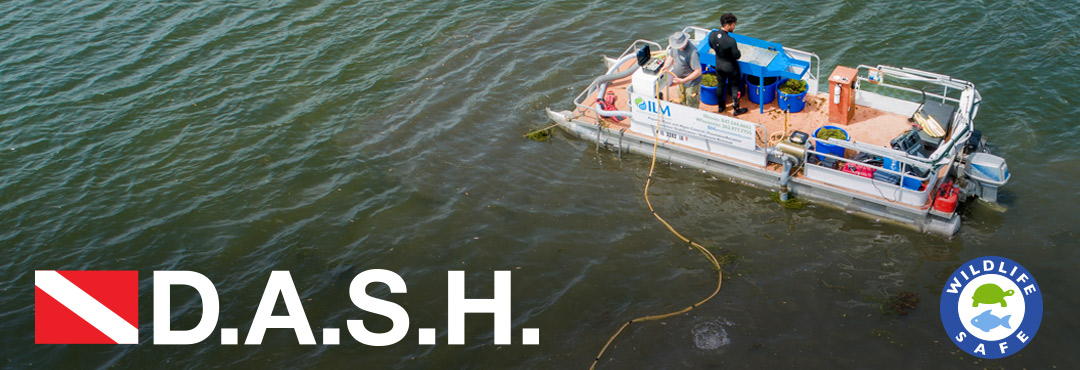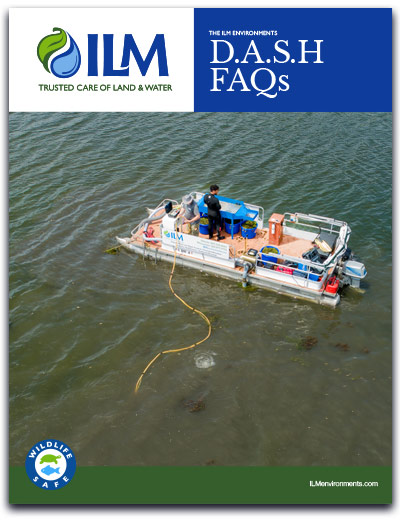
D.A.S.H. FAQs
What is D.A.S.H.?
D.A.S.H. stands for Diver Assisted Suction Harvesting and is an environmentally friendly, chemical free alternative to remove aquatic weeds. Divers identify invasive plants and pull them out by the roots and feed them into a suction tube that transports them to a boat to be hauled away. The results are immediate and chemical-free.
I’ve seen harvesters out on our lake.
How is D.A.S.H. different?
Most harvesters work like an underwater lawnmower. A cutter bar severs the vegetation as the machine moves forward through the water and stores the plants in a storage hold. When the storage hold becomes full, the weed harvester returns to shore to unload. Because the roots are left intact, the plant will continue to grow, requiring continuous harvesting throughout the season. In the case of Eurasian Water Milfoil, fragments created as result of the harvesting process can float off and become new plants, perpetuating the problem.
D.A.S.H. is weeding your lake bottom. Our divers pull the plants up by the roots and feed them into a suction hose that takes the plant material to the boat. Most fragments are sucked in during the process but any that do float to the surface are skimmed with a net and disposed.
It is good to keep in mind that D.A.S.H. is a slower process than harvesting. Most people interested in DASH are looking to have invasive plants cleared from their docks and swimming areas.
How do you know which plants are good and which ones are bad?
Our crew consists of ecologists experienced in knowing how to tell the difference between beneficial native plants and destructive invasive plants that upset the balance of your lake or pond. Remaining native plants support fish and other wildlife that are an integral part of any aquatic environment.
Can you suck up sediment while you are down there?
Since the D.A.S.H. process collects the plants in a mesh bag that lets the water pass through quickly, there is no way to contain the sediment. We can, however, use D.A.S.H. to remove accumulated leaf material.
If sediment is your issue, we can hydraulically dredge using our Truxor or Dino 6 dredges. The sediment is removed using a cutter head that works its way along the bottom sending the sediment through a tube into a dewatering bag located on shore. The holes in the dewatering bags are very small, and so only water is slowly released over time. A special permit is required for dredging.
Do you need a permit for D.A.S.H.?
You do need a permit in Wisconsin but not in Illinois. We apply for the permit on your behalf.
Do I have to deal with the plant material?
Nope, we haul it away for you. This service is included in our price.
How much area can you cover in a day?
This depends on the types of plants we are removing and how dense they are. Some plants have stronger roots systems than others (for instance Coontail pulls our easily but Eurasian Water Milfoil is more difficult) and the denser the colonies the longer is takes to remove them. On average, however, we can harvest a quarter acre in one day.
What happens to the creatures that are living in the plants you remove?
This is one area that sets us apart from other D.A.S.H. providers. Instead of going directly into a mesh bag once the plants reach the boat, we send them across a sorting table where we pick out any bycatch and return the creatures back to the water. In our case, the D.A.S.H. process is both chemical free and wildlife safe.

D.A.S.H. Resources
Watch the D.A.S.H. video on YouTube
Would you like more information on D.A.S.H. and how it can help your lake? Let’s talk!
email:
hello@ilmenvironments.com
Call ILM Illinois:
(847) 244-6662
Call ILM Wisconsin:
(262) 977-7755
